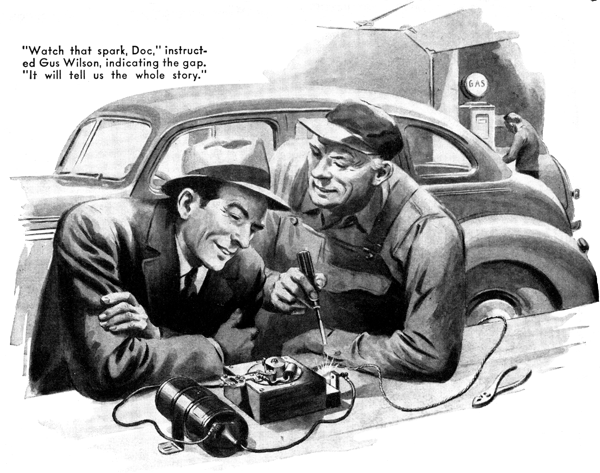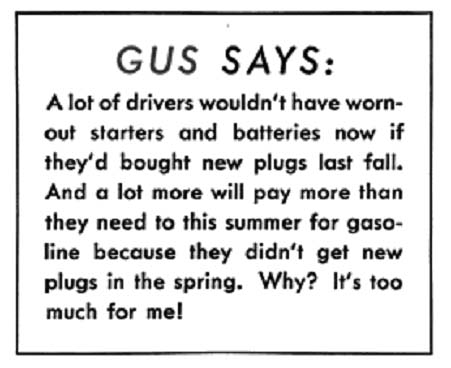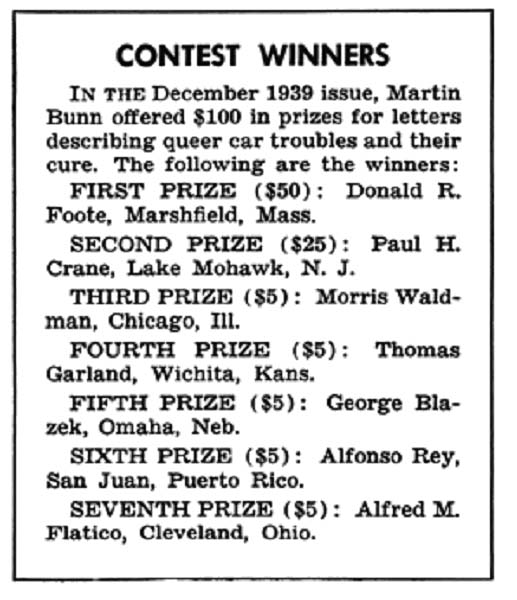April 1940

"Starts hard, and stalls in traffic once in a while, hey?" Gus Wilson said, "I guess you know the answer as well as I do, Doc." "A hundred to one something has gone wrong in your ignition system."
Dr. Marvin, who in addition to being the town's top children's physician is an enthusiastic amateur automobile mechanic, nodded agreement. "That's what I figured," he said, "but I haven't had a chance to locate the trouble. It might be in the distributor, it might be in the coil, and it might be in the condenser."
"Yep," Gus agreed as he fired up his pipe. "And then again, it might be in the wiring. Wiring can play you some funny tricks. Just this morning a young fellow drove a '31 sedan in here to have a new battery cable put in. He said he'd bought the job dirt cheap a couple of weeks ago, but at that he'd got stung, because it had a grabbing clutch that made the car jerk whenever he started out. He said that he'd had the bus in a half dozen shops. And that after testing it, each said that the clutch was hard. "Well, I put in a new battery ground cable and then I thought I'd better take a quick look at the rest of the wiring. As soon as I'd taken up the floorboards I noticed that the insulation of the other battery cable, the one which runs from the battery to the starting-motor switch, had been chewed off right down to the bare wire. The cable ran under the floorboards close to the clutch pedal, and the cotter pin in the pedal joint had worked part way out and cut into the insulation every time the pedal was moved. Of course, whenever the pin came in contact with the bare wire the result was a short which made the engine skip and the car jerk. That was the "bad clutch" which made the young fellow so sure that he had been gypped. I fixed it by taping the bad spot and putting in a new cotter pin-and saved him somewhere between ten and twenty bucks."
"That was a queer one," Dr. Marvin said interestedly. "I remember one something like it. Once I was having trouble with -- ", he broke off and looked at his watch. "Darn you, Gus Wilson!" he growled. "Every time I come into this shop I get listening to you and fall way behind on my schedule! I've got a lot of calls to make this afternoon, but I'd like to get you to check my ignition and fix up whatever is wrong with it. Suppose I send the car over about four o'clock -- could you get it ready so that I could use it tomorrow morning?" I don't think I'll have to make any calls this evening. If I do, I'll get a taxi. I hate to ask you to work overtime, but -- "
"That's all right," Gus assured him, "You do a lot of overtime work, Doc. Why shouldn't I? But if you're not doing anything special this evening, why not bring the car over yourself about half past seven? If you do, I'll show you how to make a simple little gadget which makes locating ignition trouble a cinch. I used to have one and for a long time I've been intending to make another. How about it?"
"Maybe I'll have as much fun with it as I've had with that vacuum tester you made me," the doctor said. "All right, Gus, I'll be here!"
When Dr. Marvin arrived he found Gus Wilson's workbench already covered with shavings and Gus plastering a bandage around a cut thumb, "Darn it all," he said disgustedly, "I can work on engines all the time and not hurt my hands twice in a year, but every time I start fooling with a wood saw or a chisel I cut myself. I guess I'll have to admit that I'm no carpenter."
"Let's see that cut," the doctor said. "Put some iodine on it? All right -- I guess you'll get over it. What do you call this gadget of yours? And what are you doing, and what do you want me to do?"
"I call it an ignition analyzer," Gus said, "I'm making a wooden box, 4" square and 2 1/2" deep, out of 1 1/2" stuff. Here's a job for you," He handed Dr. Marvin a 1" long piece of 1/4" brass rod, and a large file. "Just file one side of that until you have a 1/2" flat surface on it, will you?"
They worked for a while in a companionable silence and an ever-thickening cloud of pipe smoke. Gus finished his box, and to one side of it screwed a 1/2" square block of wood. To this block he screwed a 1" by 1/2" strip of 1/4" metal threaded near its upper end to take an 8-32 machine screw. Then he went over to the other side of the shop and began to rummage through a big box in which he keeps a collection of old car parts. Finding what he was looking for, he came back to the workbench just as Dr. Marvin finished his filing job.
He held up the object that he had salvaged from what his partner, Joe Clark, contemptuously calls the junk box. "This is an old windshield fan motor," he said, "but it works all right. You can buy a new one in any accessory store. The motor from one of those old motor-driven horns will do just as well, if you happen to have one around your garage. Now I'll drill a hole through that piece of brass rod you've been filing so industriously . . . so. And now I'll fasten it with a machine screw to the threaded hole I put in the end of the motor shaft . . . so. Now that will be all right."
"I wish," Dr. Marvin said, "you'd tell me what the devil you're driving at!"
Gus grinned widely. "Patience is a virtue. I'll bet you've pulled that line many a time, Doc. Just wait until I've finished up a couple of other little jobs and I'll tell you all about it." He screwed the fan motor directly to the bottom of the box, with its shaft pointing upward. Then he attached a metal top to the box, through which the piece of flattened brass rod fastened to the end of the shaft protruded, its lower edge a scant 1/4" above it. Then he took an 8-32 machine screw, filed its end to a point, and screwed it through the strip of metal he had fastened to the wooden block he had screwed to the outside of the box. "There you are!" he said. "The Gus Wilson Ignition Analyzer, all ready to analyze!"
Dr. Marvin examined the gadget carefully, and then shook his head. "It just doesn't make sense to me," he admitted.
Follow this sketch to make
the ignition tester yourself.
Gus tells you how to use it
in the story as he and Doc
Marvin build one.
Gus laughed. "It will," he said. "If you'll drive your car in, Doc, and park it as close to the bench as you can, this little instrument will tell you exactly what has gone wrong with your ignition system, without you having to move away from this bench."
Dr. Marvin drove his car in and stopped it close to the bench. Gus raised the hood took off the distributor cap, unscrewed the head plate which carried the points and condenser, removed it, and then mounted it on the metal top of the analyzer box as shown in the drawing. "You'll notice," he said, "that the flattened brass rod takes the place of the cam used in the car to open the points. When the motor of the analyzer is rotating, the points will open once with every revolution of the motor's shaft."
He took the ignition coil out of the car, placed it on the bench, and connected it to the analyzer, the wire from the coil's high-tension terminal running to the head of the pointed machine screw. "This is important," he said as he adjusted the screw carefully. "There must be a gap of exactly 1/2" between the point of the screw and the metal plate on the top of the box." Then he connected the analyzer to the car's frame for a ground.
"When I start the motor," he explained, "we should get a spark across that gap between the point of the screw and the metal top of the box. Watch that spark, Doc. It will tell us the whole story. If it jumps right across the gap and is fat and blue-white, there's nothing wrong with your ignition system. If the spark doesn't jump the gap, or isn't fat and blue-white, then there's something wrong-and the spark will tell us what it is. Let's go." He switched on the tiny electric motor. The spark jumped the gap, all right, but it wasn't fat and blue-white. It was stringy, and reddish in color. Gus watched it for a few seconds, and then switched off the motor.
"Thought so," he said. "The trouble is an open circuit in the coil's secondary winding. That's what's been causing those hard starts and the stalling in traffic that you told me about. There's only one sensible remedy Doc, a new coil. No sense fooling with this one. Sooner or later the 'open' will become longer, and then your engine won't start at all."
"All right," Dr. Marvin said. "Put in a new coil. Have you got one on hand?" Gus nodded. "Before I put it in your car," he said, "we'll test it out on the analyzer."
Gus soon came back from the stock room with the new coil and connected it to the analyzer in place of the old one. Then he switched on the electric motor again. The spark began to jump the gap with a peppery crack-crack-crunch-a spark that was fat and hot and blue-white. They watched it for a half minute, and then Gus switched off the analyzer motor.
"Well," Dr. Marvin said, "your ignition analyzer has proved to my satisfaction that I needed a new coil, and I haven't the slightest doubt that the new coil will do away with the trouble I've been having. That's all to the good. But suppose the trouble had been caused by something else. How would your analyzer have shown it up then?"
Gus perched his large frame on his workbench. "To tell you what you want to know, I'll have to sound off for a few minutes." He grinned cheerfully. "Well, now, the main thing to keep in mind is that when the analyzer produces a fat, blue-white spare which jumps the full half-inch gap, there's not a thing wrong with your ignition system, but when the analyzer doesn't produce that kind of spark, there is something wrong with your ignition system.
"Suppose you start the analyzer motor, and the resulting spark is fat and blue-white, but doesn't jump more than 1/4". That shows that your coil has shorted turns in its secondary. The sensible remedy is the same as for a coil with an open circuit in its secondary-a new coil.
"Sometimes you get a fat, blue-white spark which is a full 1/2" long, but which misses now and then. That sort of spark makes an engine stall while it's starting, and is the cause of poor acceleration and of backfiring. The trouble is a coil which 'opens' intermittently. The remedy is the same, a new coil, but before you buy one, check on your condenser. A condenser that's in bad shape will cause an intermittent miss. Also, a short, weak spark usually is caused by a poor condenser, or one of the wrong capacity. Until you've had a good deal of trouble-shooting experience, it's a good idea to suspect the condenser first and the coil second.
"Poor condensers cause a lot of distributor-point grief, too. They're often the underlying cause of an engine being hard on points, and they're the most common cause of burned points. "Even if your coil and condenser are in good shape, you can't get the most out of your ignition system unless the distributor points are perfectly spaced. If the points are set too close they'll cause hard starting. Using the ignition analyzer, you can determine the best point-spacing for your car by carefully adjusting the points while the tester motor is running until you get the fattest, longest spark possible on the tester with steady firing. When you replace the distributor head plate, set the points to exactly that gap, and you'll get the highest possible ignition efficiently . . . Well, what do you think of my ignition analyzer?"
"I think," Dr. Marvin said, "that it's a darned interesting and darned useful gadget, and I'm going to make one the first evening that I can get to myself."
END
L. Osbone 2019


